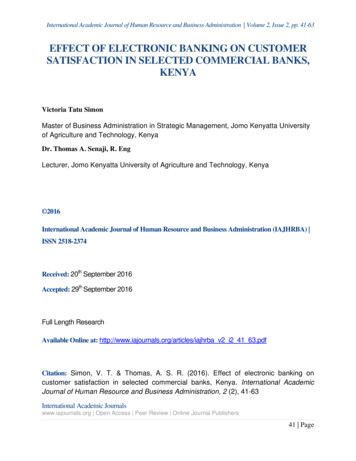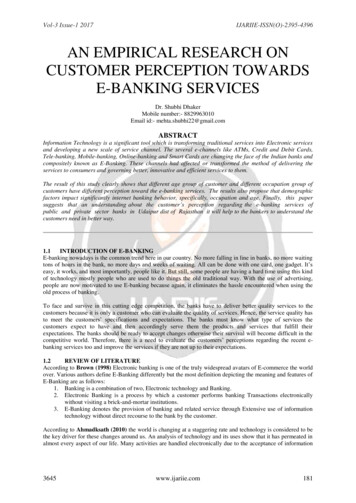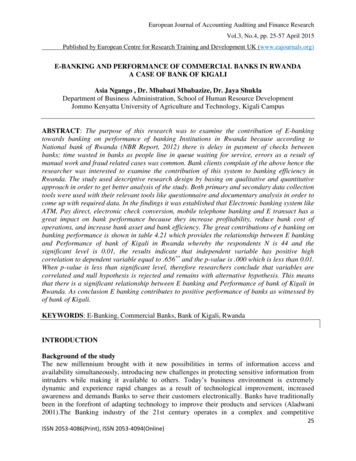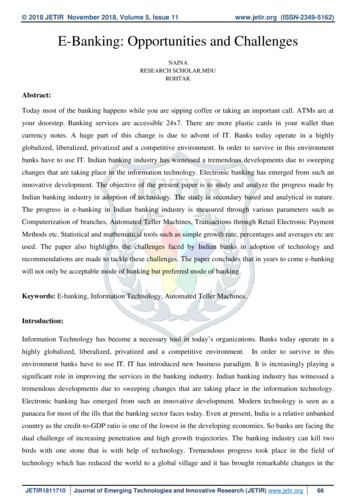
Transcription
International Academic Journal of Human Resource and Business Administration Volume 2, Issue 2, pp. 41-63EFFECT OF ELECTRONIC BANKING ON CUSTOMERSATISFACTION IN SELECTED COMMERCIAL BANKS,KENYAVictoria Tatu SimonMaster of Business Administration in Strategic Management, Jomo Kenyatta Universityof Agriculture and Technology, KenyaDr. Thomas A. Senaji, R. EngLecturer, Jomo Kenyatta University of Agriculture and Technology, Kenya 2016International Academic Journal of Human Resource and Business Administration (IAJHRBA) ISSN 2518-2374Received: 20th September 2016Accepted: 29th September 2016Full Length ResearchAvailable Online at: http://www.iajournals.org/articles/iajhrba v2 i2 41 63.pdfCitation: Simon, V. T. & Thomas, A. S. R. (2016). Effect of electronic banking oncustomer satisfaction in selected commercial banks, Kenya. International AcademicJournal of Human Resource and Business Administration, 2 (2), 41-63International Academic Journalswww.iajournals.org Open Access Peer Review Online Journal Publishers41 Page
International Academic Journal of Human Resource and Business Administration Volume 2, Issue 2, pp. 41-63ABSTRACTIn the bid to catch up with globaldevelopments and improve the quality ofservice delivery, it is in no doubt that bankshave invested much on technology, andhave widely adopted electronic andtelecommunication networks for delivering awide range of value added products andservices. However, the integration ofcustomers into electronic banking is far frombeen realized. The general aim of the studywas to determine the effect of electronicbanking and customer satisfaction amongfirst tier bank in Nairobi Town. The studywas hinged on diffusion innovation theoryand contrast theory. The study adopted adescriptive survey research design. Thetarget population was 262511 customersdrawn from 5 first tier banks within NairobiCBD. Stratified sampling technique wasused to select a sample size 225 respondents.Primary data was collected using structuredquestionnaires addressed to the participants.The researcher conducted initial dataanalysis using descriptive statisticalmeasures. The study also conducted aregression analysis to establish therelationship between the study variables.From the findings, the study concluded thatflexibility of internet banking influencecustomer satisfaction to a great extent. Inaddition, many customers use internetbanking because it is easy to use whilepersonalized internet banking also affectscustomer satisfaction to a great extent. Thestudy further concludes that usefulness ofinternet banking and friendliness of internetbanking has relatively low effect oncustomer satisfaction. The study alsoconcludes that convenience of mobilebanking affects customer satisfaction to agreat. Further, the study concluded that userfriendly ATMs, ease of access of ATMs andprivacy of ATMs affects customersatisfaction to a great extent. In addition,using ATM cards in supermarket andaffordability of ATM charges have moderateeffect on customer satisfaction. In relation topoint of sale system, the study concludesthat, effectiveness of point of sale systemaffects customer satisfaction to a greatextent. Finally, it was clear that mobilebanking has the highest effect on Customersatisfaction followed by automated tellermachines, then point of sale system whileinternet banking had the least effect oncustomer satisfaction. Banking institutionsshould enhance their internet banking tomake it flexible, fast and easy to use.Management of banking institutions shouldenhance application of mobile banking toincrease satisfaction of their customers.Mobile service providers in conjunctionwith banks should develop more friendlyand easy to use and efficient applications forbank customers. Finally, the bankinginstitutions should work hand in hand withmajor retail outlets and other organizationsthat use point of sale systems so as to ensurethe cards issued to customers and point ofsale systems are useful, reliable and canwork with speed.KeyWords:E-banking,customersatisfaction, internet banking, automatedteller machines, mobile banking, point ofsale serviceInternational Academic Journalswww.iajournals.org Open Access Peer Review Online Journal Publishers42 Page
International Academic Journal of Human Resource and Business Administration Volume 2, Issue 2, pp. 41-63INTRODUCTIONElectronic banking is considered as a new revolution of the traditional banking services whichoffers customers the greatest expediency for performing banking transactions viaelectronic. All banks, especially the large banks and mutual banks, have gradually increased theirnumber of Internet banking services available to customers over the past decades (Momeni,2013). Advances in electronic banking technology have created new ways of handling bankingtransactions, especially via the online banking channel. A feature of the banking industry acrossthe globe has been that it is increasingly becoming turbulent and competitive, characterized byan increasing trend towards internationalization, mergers, takeovers and consolidation of thebanking industry(Muhammad, Akin & Abdul, 2015). In light of the recent financial crisis andglobal economic recession, leaders of financial institutions are under additional pressure not onlyto maintain customer satisfaction while sustaining lower costs, but also to maintain marketleadership. To lower costs and maintain market leadership, bank leaders have capitalized onsuperior service quality and information technology infrastructures.To convey with this customer’ desire the banks need to change towards the modern banking.Information and Communication Technology (ICT) have changed means of business andmethods of operations in various businesses. Virtual banking includes all non- traditional andelectronic means of banking such as ATM, Phone Banking, Internet Banking (IB), Credit Cardsand Debit Cards etc. A special feature of virtual banking is the physical absence of the personseeking banking services at the premises and out of premises even abroad. The sophisticated anddeveloped E-banking services were introduced to enhance service delivery and customersatisfaction and then customer loyalty toward the organization. According to the Al-Madi (2010),the availability of Automated Teller Machines (ATM), cards, telephone banking, personalcomputer banking and internet banking has been existed nowadays in banking system (Narteh,2014).Electronic banking (E-banking) has improved as well as changed the aspect of commercialbanking through linking and connecting geographical, industrial and regulatory gaps and creatinginnovative products as well as services for both banks and customers (Khan & Karim, 2010). Inother words, Internet technology holds the potential to fundamentally change banks and thebanking industry. An understanding of the extent of the customers’ adoption or utilization ofinternet banking services has become critical. Sarlak and Hastiani (2011) recommended thatbanks and financial companies must survey customers’ requirements on a regular basis in orderto understand factors that can affect their adoption or usage of internet banking.Africa and in other developing countries, e-commerce adoption has been inhibited by the quality,availability and the cost of accessing telecommunication infrastructures (Jalal, Marzooq & Nabi,2011). Other issues include lack of skilled staff; low internet penetration, low bank account, andInternational Academic Journalswww.iajournals.org Open Access Peer Review Online Journal Publishers43 Page
International Academic Journal of Human Resource and Business Administration Volume 2, Issue 2, pp. 41-63lack of timely delivery of physical goods also hinder the growth of e-banking. The bankingsector in the African region has benefited from the rapid penetration of mobile technology inrecent years across the continent – a very good example being the success of mobile payments inKenya. Such technological advancements are not just shaping how people interact with oneanother; they are also changing the behaviour and expectation of bank customers who areincreasingly becoming used to the immediacy offered by technology.Kenyan banks have exponentially embraced the use of information and communicationtechnologies in their service provision. They have invested huge amounts of money inimplementing the self and virtual banking services with the objective of improving the quality ofcustomer service. Common embodiments of e-banking include the following: Mobile/SMSBanking, Telephone Banking, Electronic funds transfers, Self Service (PC) Banking, POSBanking (Credit and Debit cards), ATMs, Interactive TV and Branchless Banking. In Kenya, forexample, we have M-Shwari, which is offered by Commercial Bank of Africa in conjunctionwith Safaricom Kenya Limited. Another form of E-Banking in Kenya is Eazzy 247 offered byEquity Bank of Kenya. There is also Straight to Bank (S2B) offered by Standard Chartered Bankof Kenya which allows one-stop online Banking and Cash management solution. In Kenya, thereis also the Hello Money offered by Barclays Bank of Kenya among other forms of electronicbanking offered by commercial banks in Kenya (CBK annual report, 2012). For customers, thepotential benefits are: more choice; greater competition and better value for money; moreinformation; better tools to manage and compare information; and faster service. E-bankingcreates opportunities for banks by promoting product development and delivery, lower barriersto entry, significant cost reduction, capacity to re-engineer different business processes, greateropportunities to sell cross border and marketing via the Internet.STATEMENT OF THE PROBLEMCustomer satisfaction is a much sought after phenomenon in today’s highly competitive andglobalized market place. Today's customers seek more than price bargains and want useful,dependable and reliable technologies. Many Kenyan banks have exponentially embraced the useof information and communication technologies in their service provision. Huge amounts ofmoney have invested in implementing the self and virtual banking services with the objective ofimproving the quality of customer service. However, the adoption of e-commerce has beeninhibited by the quality, availability and the cost of accessing telecommunication infrastructures,lack of skilled staff, low internet penetration, low bank account, and lack of timely delivery ofphysical goods (Jalal, Marzooq & Nabi, 2011). In the bid to catch up with global developmentsand improve the quality of their service delivery, Kenyan banks have invested much ontechnology; and have widely adopted electronic and telecommunication networks for deliveringa wide range of value added products and services (GoK, 2010). Unlike before when ledgercards were used, today banking has been connected to computer networks, thereby facilitatingInternational Academic Journalswww.iajournals.org Open Access Peer Review Online Journal Publishers44 Page
International Academic Journal of Human Resource and Business Administration Volume 2, Issue 2, pp. 41-63the practice of inter-bank/inter-branch banking transactions (CBK, 2011). Developments athome, such as the introduction of mobile telephone in 2001 and improved access to personalcomputers and Internet service facilities have also added to the growth of electronic banking inthe country.However, whereas local banks most commonly practice real time online intranet banking, theintegration of customers into the process is far from been realized. Many of the reasons areattributed to the high prevalence of internet fraud and lack of an adequate regulatory frameworkto protect the banks from the volatility of risks associated with Internet banking, especially at thelevels of communication and transaction. In Kenya, most of bank customers have raisedcomplaints on improving service delivery, an issues banks have overlooked, especially whenusing modern technologies (Aker, 2010). The high level of commercial bank customerdissatisfaction with the services has been previously identified (Aker, 2010; Bichanga & Wario,2014; Kombo, Paulík & Kwarteng, 2016). Key challenges of electronic banking are: getting thebalance between convenience, speed and security. The problem is designing products that offer abalance between competitive pricing and functionality, keeping abreast with dynamism ofcustomer needs and innovation and lack of proper legislative framework to support the growth ofe-banking. Statistics obtained on the number of over the counter transactions in these banks inthe past indicated that indeed, over the counter transactions are still preferred by many clients.The question that is raised then is why? One problem associated with this financial innovation iscard fraud, particularly on counterfeit cards. Fraudulently authorized EFTs and RTGSs are theother avenues through which financial losses occur as customers utilize these avenues of servicedelivery. Frequent system failure especially on ATM machines has also been of concern andaffects quality customer service delivery especially during end month and during festive seasonswhen the service is most needed by customers. In addition, complaints have also been raised onfailures at Point of Sale terminals in stores whenever access to the host bank fails, thus causinginconveniences to customers, sometimes leading to litigations.Adoption of technology in the financial sector have been examined in several studies Anbalagan(2011) and Gikandi and Bloor (2010) observed that half of the people that have tried bankingservices through internet banking will not become active users. Berger (2013) claims thatinternet banking is not living up to the hype. Juma (2013) studied the influence of electronicbanking services on customer service delivery in banking industry, in Bungoma County. Adudaand Kingoo (2012) also studied the Relationship between Electronic Banking and FinancialPerformance among Commercial Banks in Kenya. In addition, Kaburu (2010), evaluated Ebanking in Kenya, Maitha (2010) analyzed the effects of E-banking in commercial banks inKenya in promoting international business, Mchemi (2013), studied E-banking Technology InKenyan Commercial Banks while, Munyoki and Ngigi (2012), investigated Challenges of ebanking adoption among the commercial banks in Kenya. Moreover, Mutunga (2013) analyzedInternational Academic Journalswww.iajournals.org Open Access Peer Review Online Journal Publishers45 Page
International Academic Journal of Human Resource and Business Administration Volume 2, Issue 2, pp. 41-63Operational Challenges In The Implementation Of E-banking At The National Bank Of Kenya,Nyabiosi (2010) also studied Taxing e-commerce in the banking industry: the case for financialtransaction tax in Kenya while, Rono (2015) evaluated the determinants of electronic bankingand operational performance of commercial banks in Kenya. However, none of the aboveresearchers has studied the effect of electronic banking on customer satisfaction amongcommercial banks in Kenya. Thus this study sought to fill this research gap.OBJECTIVES OF THE STUDYThe general objective of the study was to determine the effect of E-banking on customersatisfaction in selected commercial banks in Kenya.SPECIFIC OBJECTIVES1. To establish the effect of internet banking on customer satisfaction among commercialbanks in Kenya.2. To determine the effect of automated teller machines on customer satisfaction amongcommercial banks in Kenya.3. To evaluate the effect of mobile banking on customer satisfaction among commercial banksin Kenya.4. To assess the effect of Point of sale service on customer satisfaction among commercialbanks in Kenya.THEORETICAL REVIEWTheory of Reasoned ActionTheory of Reasoned Action, (TRA) was developed to better understand relationships betweenattitudes, intentions and behaviors (Fishbein, 1967). This is one of the most important theoriesthat are used to explain human behaviors (Poon 2008). Behavioral intention to use technology isexplained by people's attitudes toward that behavior and subjective norms. Intensifiedcompetition and deregulation has led many services and retail businesses to seek profitable waysto differentiate them; one strategy that has been related to success in these businesses is thedelivery of high service quality (Cheah, 2011). So service quality has become a significantresearch topic in past decade due to high revenues, increased cross sell ratios, higher customerretention, purchasing behaviors (Kaynak & Harcar, 2015) and expanded market share. Thesignificance of customer service in the banking sector came to force to compete in a marketdriven environment. The service sector as a whole is very heterogeneous and what isheterogeneous may hold true for one service and may not hold for another service sector. Due tothis differentiation, services in this industry could not be standardized, moreover these servicesInternational Academic Journalswww.iajournals.org Open Access Peer Review Online Journal Publishers46 Page
International Academic Journal of Human Resource and Business Administration Volume 2, Issue 2, pp. 41-63are intangible in nature which could not be compared or seen. The concept of customersatisfaction and service quality is interrelated with each otherAs electronic banking is becoming more prevalent, so is the level of customer service deliverythus the level of customer satisfaction is also changing the scenario of technological environment(Hamisah, 2013). Informational technology in form of e-banking plays a significant role inproviding better services at lower cost. Increase satisfaction in turn increases the mutualunderstanding, customer retention and a bond of trust between customer and bank. The bankswhich are providing these services at large extent to customers are more reputed in the eyes ofcustomers. As the customer satisfaction is the function of customer expectation level and servicequality level provided by the organization, e-banking plays a pivotal role in giving satisfaction tothe customers because e-banking fills the gap between the expected and perceived servicequality.Innovation Diffusion TheoryThis theory postulated by Roger (1983) explains individuals’ intention to adopt a technology as amodality to perform a traditional activity. The critical factors that determine the adoption of aninnovation at the general level are the following: relative advantage, compatibility, complexity,trialability and observability. Many banks have found it advantageous to adopt ICT in theiroperation in order to improve their efficiency. This is achieved through development of websitesand mobile applications that suit the customer needs. Customers are therefore able to access theiraccounts anywhere as long as they are connected to the internet. This theory is concerned withthe manner in which a new technological idea, artefact or technique, or a new use of an old one,migrates from creation to use. According to IDT, technological innovation is communicatedthrough particular channels, over time, among the members of a social system.The stages through which a technological innovation passes are: knowledge (exposure to itsexistence, and understanding of its functions); persuasion (the forming of a favourable attitude toit); decision (commitment to its adoption); implementation (putting it to use); and confirmation(reinforcement based on positive outcomes from it) (Arnaboldi & Claeys, 2008). In the sameway internet banking has been enhanced due to cyber threats and fraud.Early users generally aremore highly educated, have higher social status, are more open to both mass media andinterpersonal channels of communication, and have more contact with change agents. Massmedia channels are relatively more important at the knowledge stage, whereas interpersonalchannels are relatively more important at the persuasion stage.Innovation decisions may be optional (where the person or organization has a real opportunity toadopt or reject the idea), collective (where a decision is reached by consensus among themembers of a system), or authority-based (where a decision is imposed by another person ororganization which possesses requisite power, status or technical expertise). Barnes and CorbittInternational Academic Journalswww.iajournals.org Open Access Peer Review Online Journal Publishers47 Page
International Academic Journal of Human Resource and Business Administration Volume 2, Issue 2, pp. 41-63(2013) advises that managers need to understand the capabilities of any particular technologyand the benefits that ensue from its use in considering what technology to use with theiroperations, as well as understand associated costs and limitations of operating that technology.He advises the general issues to consider as the volume and variety of output that the technologycan achieve, the fit with existing technology used with the organisation and the level of maturityof the technology. Internet banking heavily relies on the ICT since it is carried out on theinternet. Customers are able to access their accounts remotely without having to physically visitthe bank.Contrast TheoryContrast theory was first introduced by Hovland, Harvey and Sherif (1987). Dawes et al (1972)define contrast theory as the tendency to magnify the discrepancy between one’s own attitudesand the attitudes represented by opinion statements. Contrast theory presents an alternative viewof the consumer post-usage evaluation process than was presented in assimilation theory in thatpost-usage evaluations lead to results in opposite predictions for the effects of expectations onsatisfaction. Through the introduction of automated teller machines, customers are able to accessfunds in their accounts ore conveniently and at any one time as compared to the old systemwhere money could only be withdrawn on the counter. A bank seeking to increase customersatisfaction must invest heavily in the ATM networks or join the existing local or internationalnetworks such as visa card or master card.While assimilation theory posits that consumers will seek to minimize the discrepancy betweenexpectation and performance, contrast theory holds that a surprise effect occurs leading to thediscrepancy being magnified or exaggerated. According to the contrast theory, any discrepancyof experience from expectations was exaggerated in the direction of discrepancy. If the firmraises expectations in his advertising, and then a customer’s experience is only slightly less thanthat promised, the product/service would be rejected as totally un-satisfactory. Conversely,under-promising in advertising and over-delivering will cause positive disconfirmation also to beexaggerated (Prathima 2003). In line with this theory, commercial banks must continue to bringin new products that increase customer satisfaction and at the same time keep up with marketstandards.Assimilation-Contrast TheoryAssimilation-contrast theory was introduced by Anderson (1973) in the context of post-exposureproduct performance based on Sherif and Hovland’s (1961) discussion of assimilation andcontrast effect. Assimilation-contrast theory suggests that if performance is within a customer’slatitude (range) of acceptance, even though it may fall short of expectation, the discrepancy wasdisregarded – assimilation will operate and the performance was deemed as acceptable. Ifperformance falls within the latitude of rejection, contrast will prevail and the difference wasInternational Academic Journalswww.iajournals.org Open Access Peer Review Online Journal Publishers48 Page
International Academic Journal of Human Resource and Business Administration Volume 2, Issue 2, pp. 41-63exaggerated, the produce/service deemed unacceptable. The assimilation-contrast theory hasbeen proposed as yet another way to explain the relationships among the variables in thedisconfirmation model. This theory is a combination of both the assimilation and the contrasttheories. This paradigm posits that satisfaction is a function of the magnitude of the discrepancybetween expected and perceived performance. As with assimilation theory, the consumers willtend to assimilate or adjust differences in perceptions about product performance to bring it inline with prior expectations but only if the discrepancy is relatively small (Frame & White,2009).Commercial banks should ensure that transfer of funds from one account to another should be asefficient as possible. This may be effected through electronic transfers either by the bank or bythe customer through internet banking. Assimilation-contrast theory attempts illustrate that boththe assimilation and the contrast theory paradigms have applicability in the study of customersatisfaction. Variables other than the magnitude of the discrepancy that might also influencewhether the assimilation effect or the contrast effect would be observed, when productperformance is difficult to judge, expectations may dominate and assimilation effects wasobserve, contrast effect would result in high involvement circumstances. The strength of theexpectations may also affect whether assimilation or contrast effects are observed (Frame &White, 2009).Commercial banks must also keep up to the expectations of the customers if they are to achievethe desired customer satisfaction. If they do not do this customers was dissatisfied and develop anegative attitude about them and this may lead to low customer loyalty. Assimilation-Contrasttheory suggests that if performance is within a customer’s latitude (range) of acceptance, eventhough it may fall short of expectation the discrepancy was disregarded – assimilation willoperate and the performance was deemed as acceptable. If performance falls within the latitudeof rejection no matter how close to expectation, contrast will prevail and the difference wasexaggerated, the product deemed unacceptable (Bauer 2006).Disconfirmation TheoryDisconfirmation theory argues that ‘satisfaction is related to the size and direction of thedisconfirmation experience that occurs as a result of comparing service performance againstexpectations. Szymanski and Henard found in the meta-analysis that the disconfirmationparadigm is the best predictor of customer satisfaction (Gardachew, 2010). Fang, Tian, and Tice(2010) cites Oliver’s updated definition on the disconfirmation theory, which states Satisfactionis the guest’s fulfillment response. It is a judgment that a product or service feature, or theproduct or service itself, provided (or is providing) a pleasurable level of consumption-relatedfulfillment, including levels of under- or over-fulfillment.International Academic Journalswww.iajournals.org Open Access Peer Review Online Journal Publishers49 Page
International Academic Journal of Human Resource and Business Administration Volume 2, Issue 2, pp. 41-63Karjaluoto, Mattila and Pento (2012) observes that amongst the most popular satisfactiontheories is the disconfirmation theory, which argues that satisfaction is related to the size anddirection of the disconfirmation experience that occurs as a result of comparing serviceperformance against expectations. Basically, satisfaction is the result of direct experiences withproducts or services, and it occurs by comparing perceptions against a standard e.g. expectations.Research also indicates that how the service was delivered is more important than the outcome ofthe service process, and dissatisfaction towards the service often simply occurs when guest’sperceptions do not meet their expectations. Commercial banks must at all times ensure that theyhave satisfied their customers if they are to expect any positive feedback from them. Customersmay also be a major source of new business through referrals. Banks should therefore invest inthe current technology; adopt new ways of doing business such as internet banking, mobilebanking and electronic fund transfers. Automated teller machines should also be user friendlyand be multifunctional such that a customer can withdraw or deposit cash through the sameATM.CONCEPTUAL FRAMEWORKInternet banking (e-banking) is the use of internet and telecommunication networks to deliver awide range of value added products and services to bank customers (Ovia, 2012) through the useof a system that allows individuals to perform banking activities at home or from their offices orover the internet. Some online banks are traditional banks which also offer online banking, whileothers are online only and have no physical presence. Online banking through traditional banksenables customers to perform all routine transactions, such as account transfers, balanceinquiries, bill payments, and stop-payment requests, and some even offer online loanapplications. Customers can access account information at any time, day or night, and this can bedone from anywhere.Recent literature has a narrow focus and ignores internet banking almost entirely; it equatesinternet money with the substitution of currency with internet gadget. For instance Nupur (2010)suggests that internet banking and internet money consists of three devices; access devices,stored value cards, and network money. Internet banking is simply the access to new devices andis therefore ignored. Internet money is the sum of stored value (smart cards) and network money(value stored on computer hard drives).Review of the literature has attempted to address the aspects of adoption of mobile phonefinancial services. It has however, not adequately linked the adoption of mobile phone financialservices on customer satisfaction. In addition, most of the previous studies (Dass and Pal, 2011),(Shin 2010), (Kumar and Ravindran, 2012), (Cheah, 2011), (Puschel et al (2010), (Kaynak andHarcar, 2015), (Poon 2008) and (Nupur 2010) Kotzab, 2009 are emanating from develop
Virtual banking includes all non- traditional and electronic means of banking such as ATM, Phone Banking, Internet Banking (IB), Credit Cards and Debit Cards etc. A special feature of virtual banking is the physical absence of the person seeking banking services at the premises and out of premises even abroad. The sophisticated and










